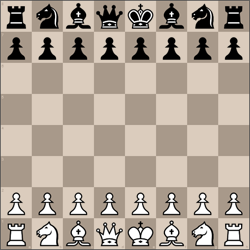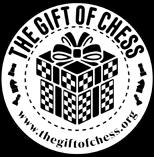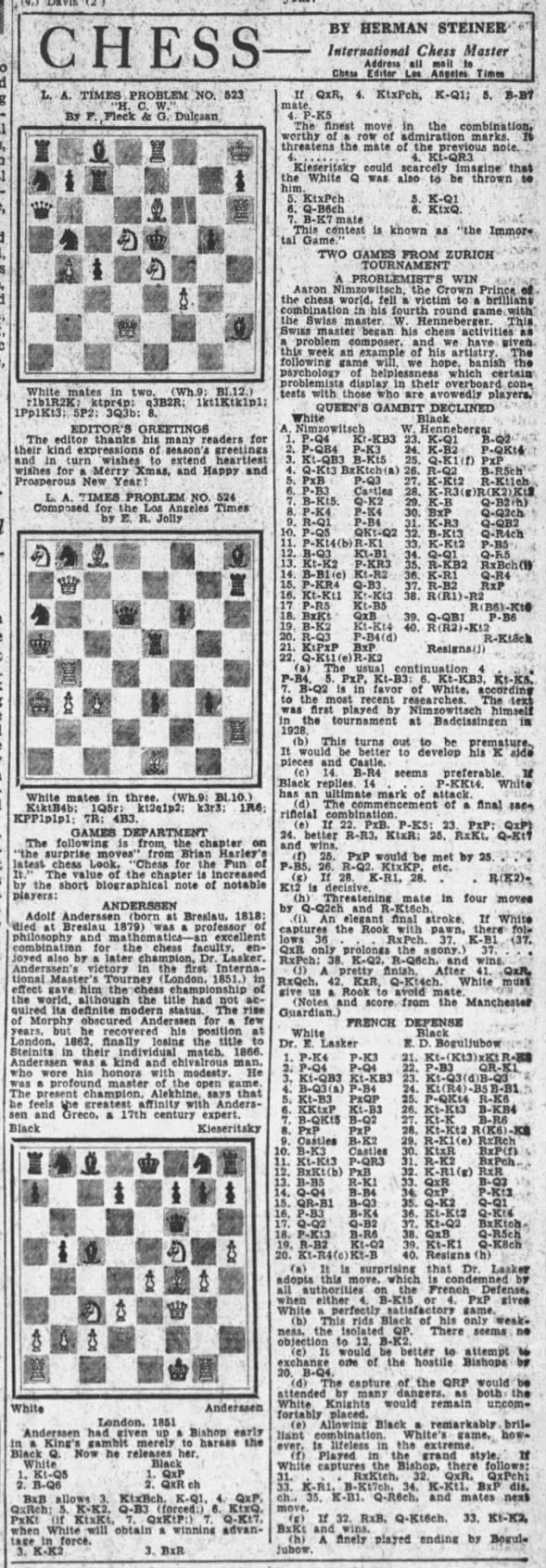< Prev
Index
Next >
 Chess by Herman Steiner 09 Dec 1934, Sun The Los Angeles Times (Los Angeles, California) Newspapers.com
Chess by Herman Steiner 09 Dec 1934, Sun The Los Angeles Times (Los Angeles, California) Newspapers.com
L.A. Times Problem No. 519 “H. C. W.” by C. S. Kipping. White mates in two.
FEN 7r/8/3p1N2/p2RP2Q/2RB1kP1/3P2p1/4B1n1/r1q3NK w - - 0 1
Solution and FEN in dispute due to Herman Steiner's absence. See February 3, 1935.
L.A. Times Problem No. 520. Composed for the Los Angeles Times by A.D. Gibbs, Long Beach, California
FEN 3b3n/2p1p1pB/2p1R1P1/2P2k1P/3pNp1K/1Q3pp1/rBP2PP1/q4R1b w - - 0 1
The second part of the tournament will be played at the rooms of the Los Angeles Chess and Checker Club, 130 South Broadway, each Saturday evening, beginning December 15. George W. Sullinger, tournament director, is now preparing schedules of play, which should be in the hands of the participants before that date.
From the Southern California Chess League:
W. H. English, Santa Barbara (white) vs. Simon Spero, East Los Angeles (black)
Philidor Defense
Submitted to chessgames.com on 04/09/2025

Descriptive
1. P-K4 P-K4
2. N-KB3 P-Q3
3. B-B4 B-K2
4. N-B3 N-KB3
5. P-Q3 N-B3
6. P-QR3 O-O
7. B-KN5 B-K3
8. BxB PxB
9. Q-Q2 N-Q5
10. NxN PxN
11. N-K2 P-K4
12. P-KB3 N-R4
13. BxB QxB
14. O-O-O N-B5
15. NxN RxN
16. QR-B QR-KB
17. Q-R5 P-QR3
18. Q-Q5ch K-R
19. QxNP Q-N4
20. K-N QxP
21. QR-N QxBP
22. QxQBP Q-B8ch
23. RxQ RxRch
24. RxR RxRch
25. K-R2 P-R3
26. QxQP K-R2
27. QxKP R-B7
28. K-N3 R-B3
29. QxP P-KR4
30. Q-K5 K-R3
31. P-KR4 P-QR4
32. Q-N5ch K-R2
33. QxRPch K-N
34. QxP K-B
35. Q-KN5 R-B2
36. P-B4 R-B3
37. P-R5 R-N3ch
38. K-B3 P-N3
39. Q-Q8ch 1-0 |
Algebraic
1. e4 e5
2. Nf3 d6
3. Bc4 Be7
4. Nc3 Nf6
5. d3 Nc6
6. a3 0-0
7. Bg5 Be6
8. Bxe6 fxe6
9. Qd2 Nd4
10. Nxd4 exd4
11. Ne2 e5
12. f3 Nh5
13. Bxe7 Qxe7
14. 0-0-0 Nf4
15. Nxf4 Rxf4
16. Rdf1 Raf8
17. Qa5 a6
18. Qd5+ Kh8
19. Qxb7 Qg5
20. Kb1 Qxg2
21. Rg1 Qxf3
22. Qxc7 Qf1+(a)
23. Rxf1 Rxf1+
24. Rxf1 Rxf1+
25. Ka2 h6
26. Qxd6 Kh7
27. Qxe5 Rf2
28. Kb3 Rf6
29. Qxd4 h5
30. Qe5 Kh6
31. h4 a5
32. Qg5+ Kh7
33. Qxh5+ Kg8
34. Qxa5 Kf8
35. Qg5 Rf7
36. c4 Rf6
37. h5 Rb6+
38. Kc3 g6
39. Qd8+ 1-0 |
(a)—Here Black moved Q-R4, saw the mate on his KN2, moved back and tried to move KR-B2. White refused to allow the move after the Queen had been touched. (Usually after such an oversight where there is no chance to overcome the lost material, resigning is in order! Ed.]
Dr. Leon Bankoff, Exposition “B” (white) vs. P. V. Kamanski, Highland Park “B” (black)
Queen's Gambit Declined

Descriptive
1. P-Q4 P-Q4
2. P-QB4 N-KB3
3. N-QB3 P-K3
4. B-N5 B-K2
5. P-K3 P-B3
6. N-B3 QN-Q2
7. Q-B2 O-O
8. P-QR3 R-K
9. P-QN4 N-B
10. P-B5 P-QN3
11. B-Q3 PxP
12. NPxP P-QR4
13. Q-K2 N-N5
14. BxB QxB
15. P-R3 N-B3
16. N-QR4 N(B3)-Q2
17. O-O P-B3
18. N-R4 P-B4
19. N-KB3 Q-B3
20. Q-B2 P-N3
21. QR-N P-K4
22. PxP NxKP
23. NxN QxN
24. N-N6 R-N
25. Q-Q2 P-Q5
26. PxP Q-B3
27. N-Q5 QxP
28. RxR QxN
29. R-B K-N2
30. Q-B3ch K-R3
31. B-R6 B-Q2
32. RxR BxR
33. Q-K3ch P-N4
34. QxB N-N3
35. Q-K3 P-B5
36. Q-QB3 N-R5
37. Q-B6ch K-R4
38. B-K2ch P-B6
39. P-N4 mate |
Algebraic
1. d4 d5
2. c4 Nf6
3. Nc3 e6
4. Bg5 Be7
5. e3 c6
6. Nf3 Nbd7
7. Qc2 0-0
8. a3 Re8
9. b4 Nf8
10. c5 b6
11. Bd3 bxc5
12. bxc5 a5
13. Qe2 Ng4
14. Bxe7 Qxe7
15. h3 Nf6
16. Na4 N6d7
17. 0-0 f6
18. Nh4 f5
19. Nf3 Qf6
20. Qc2 g6
21. Rb1 e5
22. dxe5 Nxe5
23. Nxe5 Qxe5
24. Nb6 Rb8
25. Qd2 d4
26. exd4 Qf6
27. Nd5 Qxd4
28. Rxb8 Qxd5
29. Rc1 Kg7
30. Qc3+ Kh6
31. Ba6 Bd7
32. Rxe8 Bxe8
33. Qe3+ g5
34. Qxe8 Ng6
35. Qe3 f4
36. Qc3 Nh4
37. Qf6+ Kh5
38. Be2+ f3
39. g4# |
Played in the championship of Czecho-Slovakia.
Stefan Fazekas (white) vs. Gillar (black)
Slav Defense: Czech Variation, Krause Attack, Fazekas Gambit

Descriptive
1. P-Q4 P-Q4
2. P-QB4 P-QB3
3. N-QB3 N-KB3
4. N-B3 PxP
5. P-QR4 B-B4
6. N-K5 N-R3
7. P-K4 NxP
8. BxP P-K3
9. NxQBP PxN
10. BxN Q-N3
11. Q-K2 B-QN5
12. O-O NxN
13. PxN BxP
14. B-R3 BxP
15. QR-B1 P-B4
16. B-N5ch K-K2
17. KR-Q1 KR-Q1
18. RxB RxR
19. BxPch 1-0 |
Algebraic
1. d4 d5
2. c4 c6
3. Nc3 Nf6
4. Nf3 dxc4
5. a4 Bf5
6. Ne5 Na6(a)
7. e4 Nxe4
8. Bxc4 e6
9. Nxc6 bxc6(b)
10. Bxa6 Qb6
11. Qe2 Bb4(c)
12. 0-0 Nxc3
13. bxc3 Bxc3
14. Ba3(d) Bxd4(e)
15. Rc1 c5(f)
16. Bb5+ Ke7
17. Rd1 Rd8(g)
18. Rxd4 Rxd4
19. Bxc5+ 1-0 |
(a)—Probably trying for N-QN5. It is a weak move, the square for N being Q2 in this variation.
(b)—If Q-N3, 10. P-R5.
(c)—Or QxQP. 10. Castles, with the threat of B-N7. Black must attend to it, with loss of time that will be serious to his uncastled K. A safer line than the text is NxN, 12. PxN B-K2.
(d)—Fine positional play, which no doubt was the chief factor in earning the brilliancy prize for this game. The Black K remains uneasy.
(e)—The best chance appears to be the capture of the exchange: BxR, 15. B-B5 (not Q-K5, QxP; 16. Q-B7 Q-Q2) Q-B2 (not Q-N7, when 16. Q-K5 would succeed;) 16. RxB A win for White takes some proving.
(f)—White's idea being RxP QxR; B-N5.
(g)—A mistake in a last positional. Curiously enough, P-N4 does not stop RxB, both Ps being pinned, and RxB follows also Q-Q3. The B can be saved for the moment by K-B3, when White could soon smash the opposition by P-N4 B-N3; P-R4 etc.
The young Hungarian, A. Lilienthal, has shown himself to be both enterprising and courageous in recent competition. The game below is from a minor tournament at Zandvoort, Holland.

(a) 4. … P-Q4 is much stronger.
(b) Sooner or later Black must play for P-Q4 to equalize, which White should now be trying to prevent, perhaps with N-B2 and K3.
(c) This is really a blunder of far-reaching consequences. 11. R-Q, with added pressure on the Q file, is correct.
(d) If 18. N-Q4, QR-Q is strong for Black.
(e) This R move is hardly satisfactory or necessary, 19. N-Q4 is probably White's best chance. Black really has a decided “edge” in his sweeping bishops.
(f) Practically compelled. Black threatens RxN! If 21. B-Q4 B-KR3!
(g) 23. QxQ NxQ; 24. K-B2 KR-Q is difficult for White.
(h) If 25. B-Q4 N-B6; 26. QxB NxR; 27. RxN QxNPch!
From the Scottish championship tournament at Glasgow between the winner and runner-up, who were separated by half a point:
William Albert Fairhurst (white) vs. James Aitken (black)
Queen's Gambit Declined: Cambridge Springs Defense, Bogoljubov Variation

Descriptive
1. P-Q4 P-Q4
2. P-QB4 P-K3
3. N-KB3 N-KB3
4. N-B3 QN-Q2
5. B-N5 P-B3
6. P-K3 Q-R4
7. N-Q2 B-N5
8. Q-B2 O-O
9. BxN NxB
10. B-Q3 R-K1
11. O-O P-K4
12. N-N3 Q-B2
13. BPxP BxN
14. P-Q6 QxP
15. PxB P-K5
16. B-K2 N-N5
17. BxN BxB
18. N-Q2 P-KB4
19. N-B4 Q-N3
20. K-R1 Q-R4
21. N-K5 R-K3
22. Q-N3 QR-K1
23. P-B3 PxP
24. PxP B-R6
25. R-KN1 K-R1
26. QxP QR-K2
27. Q-B8ch R-K1
28. Q-Q7 P-N3
29. R-N5 Q-R5
30. QR-KN1 Q-B7
31. NxPch PxN
32. R-R5ch K-N1
33. RxPch RxR
34. QxRch K-N2
35. Q-R8ch K-B2
36. R-R7ch 1-0 |
Algebraic
1. d4 d5
2. c4 e6
3. Nf3 Nf6
4. Nc3 Nd7
5. Bg5 c6
6. e3 Qa5
7. Nd2 Bb4
8. Qc2 0-0
9. Bxf6 Nxf6
10. Bd3 Re8
11. 0-0 e5
12. Nb3 Qc7
13. cxd5 Bxc3
14. d6 Qxd6
15. bxc3 e4
16. Be2 Ng4
17. Bxg4 Bxg4
18. Nd2 f5
19. Nc4 Qg6
20. Kh1 Qh5
21. Ne5 Re6
22. Qb3 Re8
23. f3 exf3
24. gxf3 Bh3
25. Rg1 Kh8
26. Qxb7 Re7
27. Qc8+ Re8
28. Qd7 g6
29. Rg5 Qh4
30. Rg1 Qf2
31. Nxg6+ hxg6
32. Rh5+ Kg8
33. Rxg6+ Rxg6
34. Qxe8+ Kg7
35. Qh8+ Kf7
36. Rh7+ 1-0 |
 Jurists Engage in Chess Game for Court Title 10 Dec 1934, Mon The Los Angeles Times (Los Angeles, California) Newspapers.com
Jurists Engage in Chess Game for Court Title 10 Dec 1934, Mon The Los Angeles Times (Los Angeles, California) Newspapers.com
 Chess by Herman Steiner 03 Mar 1935, Sun The Los Angeles Times (Los Angeles, California) Newspapers.com
Chess by Herman Steiner 03 Mar 1935, Sun The Los Angeles Times (Los Angeles, California) Newspapers.com
















































